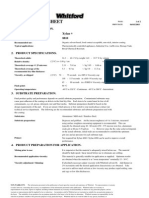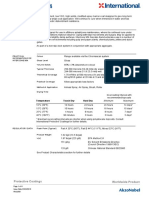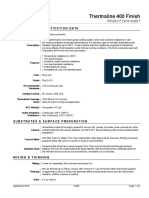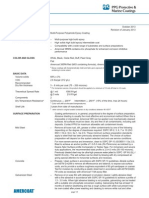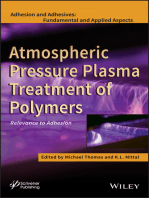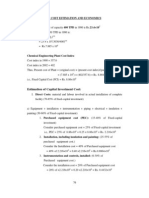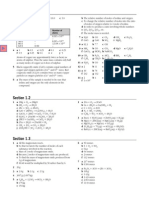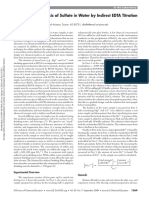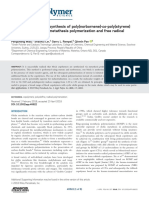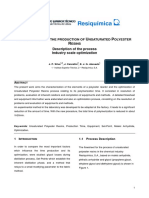Carboguard 885 PDS
Carboguard 885 PDS
Uploaded by
syazwanjohnmazlanCopyright:
Available Formats
Carboguard 885 PDS
Carboguard 885 PDS
Uploaded by
syazwanjohnmazlanCopyright
Available Formats
Share this document
Did you find this document useful?
Is this content inappropriate?
Copyright:
Available Formats
Carboguard 885 PDS
Carboguard 885 PDS
Uploaded by
syazwanjohnmazlanCopyright:
Available Formats
Carboguard 885
Selection & Specification Data
Generic Type
Epoxy Polyamide
Description
Versatile corrosion resistant coating. Used either as
a primer, intermediate coat, or self-priming finish over
steel or zinc primers. May be topcoated with itself,
or a broad variety of high performance finish coats.
Has surface tolerant properties. It has versatile uses
in the marine and offshore industries for both above
and below the waterline. Carboguard 885 LT has 35F
cure capability (see seperate data sheet).
Features
Ready to apply after mixing; no sweat-in time or
thinning required
Economical fit for use epoxy
Available in a variety of rapid tint colors
Attractive low sheen for tank exteriors
Used as a primer, intermediate, or finish coat
Power tool cleaned surfaces acceptable
Optional low temperature (LT) cure Part B
VOC compliant to current AIM regulations
Color
Primer color (0700) gray. Variety of other finish coat
colors in rapid tint service. Use Bright White (F800) for
tank exterior finish.
Finish
Satin
Primer
Self-priming. May be applied over zinc rich primers. A
mist coat may be required to minimize bubbling over
inorganic zinc rich primers.
Dry Film
Thickness
3.0 - 5.0 mils (76 - 127 microns) per coat as a primer
or intermediate
4.0 - 6.0 mils (102 - 152 microns) per coat as a finish
coat over a primer
Substrates & Surface Preparation
General
Surfaces must be clean and dry. Employ adequate
methods to remove dirt, dust, oil and all other
contaminants that could interfere with adhesion of the
coating.
Steel
For most applications: SSPC-SP6 to obtain a blast
profile of 1.0-2.0 mils (25-50 microns). May also be
applied over SSPC-SP 3 when needed.
Concrete or CMU
Concrete must be cured 28 days at 75F (24C) and
50% relative humidity or equivalent. Prepare surfaces
in accordance with ASTM D4258 Surface Cleaning of
Concrete and ASTM D4259 Abrading Concrete. Voids
in concrete may require surfacing.
Performance Data
Test Method
ASTM D4541 Adhesion
ASTM D522 Flexibility
By Volume 62% +/- 2%
Theoretical
Coverage Rate
994 ft at 1.0 mils (24.4 m /l at 25 microns)
331 ft at 3.0 mils (8.1 m /l at 75 microns)
Results
1600 psi (Pneumatic)
90 degree bend
produced no cracking,
3/4 Cylindrical
Mandrel Bend
Mixing & Thinning
Mixing
Power mix separately, then combine and power mix.
DO NOT MIX PARTIAL KITS.
Thinning
Normally not required but may thin as follows: Spray:
Up to 15 oz/gal (12%) wth Thinner # 10 Brush and
Roll: Up to 4 oz/gal (3%) with Thinner #33. Thinner
236E or 243E may be used as an exempt thinner in
lieu of those listed above. Use of thinners other than
those supplied or recommended by Carboline may
adversely affect product performance and void product
warranty, whether expressed or implied.
Ratio
1:1 Ratio (A to B)
Pot Life
4 Hours at 75F (24C) Pot life ends when coating
thickens and loses application properties. Pot life
times will be less at higher temperatures.
Do not exceed 10 mils (250 microns) in a single coat. Excessive film
thickness over inorganic zincs may increase damage during shipping or
erection.
Solids Content
System
Blasted Steel 2 ct.
Blasted Steel 1 ct.
166 ft at 6.0 mils (4.1 m /l at 150 microns)
Allow for loss in mixing and application.
VOC Values
Limitations
Topcoats
July 2012
Thinner 10 15 oz/gal 3.26 lbs./gal 391 g/l
Thinner 236 E 16 oz/gal 2.80 lbs/gal 336 g/l
Thinner 243 E 16 oz/gal 2.80 lbs/gal 336 g/l
Thinner 33 16 oz/gal 3.31 lbs/gal 397 g/l
As Supplied 2.80 lbs./gal 336 g/l
Epoxies lose gloss, discolor and eventually chalk
in sunlight exposure. LT Cure will cause additional
discoloration as it weathers and/or ages. When used
for immersion projects the following colors need to be
used: Red (A590), White (5839), Grey (C705), Buff
(0217), and Black (C900)
May be coated with Acrylics, Epoxies, Alkyds, or
Polyurethanes depending on exposure and need.
Application Equipment Guidelines
Listed below are general equipment guidelines for the application of this product. Job site conditions
may require modifications to these guidelines to achieve the desired results.
Conventional
Spray
Pressure pot equipped with dual regulators, 3/8
I.D. minimum material hose, .070 I.D. fluid tip and
appropriate air cap.
Airless Spray
Pump Ratio: 30:1 (min.)*
GPM Output: 2.5 (min.)
Material Hose: 3/8 I.D. (min.)
Tip Size: .017-.021
Output PSI: 2100-2300
Filter Size: 60 mesh
*Teflon packings are recommended and available from
the pump manufacturer.
1054
To the best of our knowledge the technical data contained herein is true and accurate on the date of publication and is subject to change without prior notice. User must contact Carboline Company
to verify correctness before specifying or ordering. No guarantee of accuracy is given or implied. We guarantee our products to conform to Carboline quality control. We assume no responsibility for
coverage, performance or injuries resulting from use. Liability, if any, is limited to replacement of products. NO OTHER WARRANTY OR GUARANTEE OF ANY KIND IS MADE BY CARBOLINE,
EXPRESS OR IMPLIED, STATUTORY, BY OPERATION OF LAW, OR OTHERWISE, INCLUDING MERCHANTABILITY AND FITNESS FOR A PARTICULAR PURPOSE. Carboline and Carboguard
are registered trademarks of Carboline Company.
Page 1 of 2
Carboguard 885
Application Equipment Guidelines
Packaging, Handling & Storage
Listed below are general equipment guidelines for the application of this product. Job site conditions
may require modifications to these guidelines to achieve the desired results.
Brush & Roller
(General)
Not recommended for tank lining applications except
when striping welds. Multiple coats may be required
to obtain desired appearance, recommended dry
film thickness and adequate hiding. Avoid excessive
rebrushing or re-rolling. For best results, tie-in within
10 minutes at 75F (24C).
Brush
Use a medium bristle brush.
Roller
Use 3/8 nap phenolic core roller.
Spray Application The following spray equipment has been
(General)
found suitable and is available from equipment
manufacturers.
Shelf Life
Part A & B: Min. 36 months at 75F (24C)
*Shelf Life: (actual stated shelf life) when kept at recommended storage
conditions and in original unopened containers.
Shipping Weight
(Approximate)
2 Gallon Kit - 26 lbs. (12 kg)
10 Gallon Kit - 127 lbs. (58 kg)
Storage
Temperature &
Humidity
40 - 110F (4- 43C)
0-100% Relative Humidity
Flash Point
(Setaflash)
Part A: 75F (24C)
Part B: 75F (24C)
Mixed: 75F (24C)
Storage
Store Indoors.
Application Conditions
Condition
Minimum
Maximum
Material
Surface
Ambient
50 F (10 C) 50 F (10 C) 50 F (10 C)
90 F (32 C) 125 F (52 C) 110 F (43 C)
Humidity
0%
85%
This product simply requires the substrate temperature to be above the dew point. Condensation
due to substrate temperatures below the dew point can cause flash rusting on prepared steel and
interfere with proper adhesion to the substrate. *Surface and ambient temperatures may be reduced
to 35C when using the (LT) cure.
Curing Schedule
Surface Temp. & 50%
Relative Humidity
35 F (2 C)
50 F (10 C)
60 F (16 C)
75 F (24 C)
90 F (32 C)
Dry to Recoat
NR
24 Hours
10 Hours
7 Hours
4 Hours
Maximum Dry to
Recoat for Immersion
NR
30 Days
30 Days
30 Days
30 Days
These times are based on a 4.0-6.0 mil (100-150 micron) dry film thickness for immersion. For
atmospheric exposures (non-immersion) the recoat time is 12 months for all temperatures. Higher
film thickness, insufficient ventilation, or cooler temperatures will require longer cure times and
could result in solvent entrapment and premature failure. Excessive humidity or condensation on the
surface during curing can interfere with the cure, can cause discoloration and may result in a surface
haze. Any haze or blush must be removed by water washing before recoating. If the maximum
recoat times have been exceeded, the surface must be abraded by sweep blasting or sanding
prior to the application of additional coats. For force curing, contact Carboline Technical Service for
specific requirements.
Cleanup & Safety
Cleanup
Use Thinner #2 or Acetone. In case of spillage, absorb
and dispose of in accordance with local applicable
regulations.
Safety
Read and follow all caution statements on this
product data sheet and on the MSDS for this product.
Employ normal workmanlike safety precautions.
Hypersensitive persons should wear protective
clothing, gloves and use protective cream on face,
hands and all exposed areas.
Ventilation
When used in enclosed areas, thorough air circulation
must be used during and after application until the
coating is cured. The ventilation system should be
capable of preventing the solvent vapor concentration
from reaching the lower explosion limit for the solvents
used. User should test and monitor exposure levels
to insure all personnel are below guidelines. If not
sure or if not able to monitor levels, use MSHA/NIOSH
approved respirator.
July 2012
1054
To the best of our knowledge the technical data contained herein is true and accurate on the date of publication and is subject to change without prior notice. User must contact Carboline Company
to verify correctness before specifying or ordering. No guarantee of accuracy is given or implied. We guarantee our products to conform to Carboline quality control. We assume no responsibility for
coverage, performance or injuries resulting from use. Liability, if any, is limited to replacement of products. NO OTHER WARRANTY OR GUARANTEE OF ANY KIND IS MADE BY CARBOLINE,
EXPRESS OR IMPLIED, STATUTORY, BY OPERATION OF LAW, OR OTHERWISE, INCLUDING MERCHANTABILITY AND FITNESS FOR A PARTICULAR PURPOSE. Carboline and Carboguard
are registered trademarks of Carboline Company.
Page 2 of 2
You might also like
- Carboguard 703 GFDocument2 pagesCarboguard 703 GFlhanx2100% (2)
- 8810Document2 pages8810Sikander Aleem100% (1)
- Framework For Product Safety ADocument26 pagesFramework For Product Safety AsyazwanjohnmazlanNo ratings yet
- Airasia Cargo - Durian Standard PackagingDocument3 pagesAirasia Cargo - Durian Standard PackagingsyazwanjohnmazlanNo ratings yet
- Science 7 Quiz BeeDocument5 pagesScience 7 Quiz BeeLouie Jane Eleccion100% (2)
- Polyethylene Terephthalate (PET) : A Comprehensive Review: What Is PET Plastic?Document8 pagesPolyethylene Terephthalate (PET) : A Comprehensive Review: What Is PET Plastic?Ahmad Shah 8999No ratings yet
- Carbocoat 8215 PDS 6-10Document2 pagesCarbocoat 8215 PDS 6-10Mayur PatelNo ratings yet
- Carbo Guard 893 SGDocument2 pagesCarbo Guard 893 SGsuzilamatsallehNo ratings yet
- Carboguard 888 PDSDocument3 pagesCarboguard 888 PDSsalamrefighNo ratings yet
- Carboguard 89dfsfs0 PDSDocument2 pagesCarboguard 89dfsfs0 PDSMayur PatelNo ratings yet
- Phenoline 187 Primer PDSDocument2 pagesPhenoline 187 Primer PDSVajid MadathilNo ratings yet
- Carboguard 890 PDSDocument2 pagesCarboguard 890 PDSLinnie McleodNo ratings yet
- Carbomastic 15 PDS 2013Document2 pagesCarbomastic 15 PDS 20134508366279No ratings yet
- Phenoline 353 PDSDocument2 pagesPhenoline 353 PDSGerson SuarezNo ratings yet
- Phenoline 1205 PDS 9-06 PDFDocument2 pagesPhenoline 1205 PDS 9-06 PDFttr_1947No ratings yet
- Carbothane+134+HG+PDS+3 11Document2 pagesCarbothane+134+HG+PDS+3 11James Everett AbdulNo ratings yet
- Carbothane 134 HG PDSDocument2 pagesCarbothane 134 HG PDSfazeel mohammedNo ratings yet
- Carbomastic 15 PDSDocument2 pagesCarbomastic 15 PDSAnonymous 4fVUDODNo ratings yet
- Thermaline 450 PDFDocument2 pagesThermaline 450 PDFNageswara Rao BavisettyNo ratings yet
- Bitumastic 300MDocument2 pagesBitumastic 300Mtharman749781No ratings yet
- Interzone 954Document0 pagesInterzone 954hennawijayaNo ratings yet
- Polyclad 975 H PDSDocument2 pagesPolyclad 975 H PDSLinnie McleodNo ratings yet
- Carbozinc 11 & 11 FG PDS 7-11Document2 pagesCarbozinc 11 & 11 FG PDS 7-11Mayur PatelNo ratings yet
- Carbo Zinc 11 HsDocument2 pagesCarbo Zinc 11 Hstyto_rmzNo ratings yet
- Carbothane 130 Clear Coat PDS 12-11Document2 pagesCarbothane 130 Clear Coat PDS 12-11Sajeesh KrishnanNo ratings yet
- Interzone 954Document4 pagesInterzone 954johnson_regoNo ratings yet
- Carbothane 134 Series PDS Sept 2012Document2 pagesCarbothane 134 Series PDS Sept 2012salamrefighNo ratings yet
- Protective Coating-3Document0 pagesProtective Coating-3Sivaratnam NavatharanNo ratings yet
- K267 - PDS - en - GBDocument2 pagesK267 - PDS - en - GBJennifer BradleyNo ratings yet
- Intergard 251 Tech Data SheetDocument0 pagesIntergard 251 Tech Data SheetL Mahender ReddyNo ratings yet
- Intertherm 50: Silicone AluminiumDocument4 pagesIntertherm 50: Silicone Aluminiumnoto.sugiartoNo ratings yet
- Interplus 1180: Protective CoatingsDocument4 pagesInterplus 1180: Protective CoatingsAnindya Aulia PratiwiNo ratings yet
- Vinyl Ester-Glass Flake PaintDocument4 pagesVinyl Ester-Glass Flake PaintSimbu ArasanNo ratings yet
- Interline 994LT - fournisseurDocument4 pagesInterline 994LT - fournisseursandrineguerin2012No ratings yet
- Thermaline 4700 PDSDocument2 pagesThermaline 4700 PDSzaheerNo ratings yet
- Penguard Express ZPDocument5 pagesPenguard Express ZPMustafa Al-YasseriNo ratings yet
- Sanitile 755 PDSDocument4 pagesSanitile 755 PDSnarmathaNo ratings yet
- Carboguard 891: Selection & Specification DataDocument4 pagesCarboguard 891: Selection & Specification DataPrakashNo ratings yet
- Formula 152 Topcoat (MILDTL-24441)Document4 pagesFormula 152 Topcoat (MILDTL-24441)Trịnh Minh KhoaNo ratings yet
- Carboguard 635: Selection & Specification DataDocument5 pagesCarboguard 635: Selection & Specification DataPrakashNo ratings yet
- Interline 399Document4 pagesInterline 399pinky_y2kNo ratings yet
- Carbozinc 858: Selection & Specification DataDocument4 pagesCarbozinc 858: Selection & Specification DataNico RoisnerNo ratings yet
- Carbozinc 11 PDS-MarineDocument2 pagesCarbozinc 11 PDS-MarineJulie WillisNo ratings yet
- Interline 1012+ds+engDocument4 pagesInterline 1012+ds+engSUBHOMOYNo ratings yet
- Thermaline 400 Primer PDSDocument3 pagesThermaline 400 Primer PDSQuy RomNo ratings yet
- 0091 Amercoat 91 PDS May 08Document2 pages0091 Amercoat 91 PDS May 08donaldoguerreroNo ratings yet
- Thermaline 400 Finish PDSDocument3 pagesThermaline 400 Finish PDSQuy RomNo ratings yet
- Carboguard 635 Thinned 50% - Sealer PDSDocument5 pagesCarboguard 635 Thinned 50% - Sealer PDSjakeNo ratings yet
- 7) PPG Amercoat 385 - Pds - AiDocument4 pages7) PPG Amercoat 385 - Pds - AididbeauNo ratings yet
- Amer Coat 385Document4 pagesAmer Coat 385Mehman NasibovNo ratings yet
- Carboguard 890 GFDocument4 pagesCarboguard 890 GFDuongthithuydungNo ratings yet
- Sylgard 160Document3 pagesSylgard 160diogocNo ratings yet
- Devran 224HS PdsDocument2 pagesDevran 224HS Pdsjopedro96No ratings yet
- 2020.10.04-AL JAZEERA-Red Oxide Primer (JI-71001)Document3 pages2020.10.04-AL JAZEERA-Red Oxide Primer (JI-71001)Jafffar MahasnehNo ratings yet
- Intergard 475HS: Primed SurfacesDocument3 pagesIntergard 475HS: Primed SurfaceskareemNo ratings yet
- Carbomastic 15 LT: Selection & Specification DataDocument3 pagesCarbomastic 15 LT: Selection & Specification Datasrinath vNo ratings yet
- E-Program Files-AN-ConnectManager-SSIS-TDS-PDF-Interspeed - 6200 - Eng - A4 - 20160729Document4 pagesE-Program Files-AN-ConnectManager-SSIS-TDS-PDF-Interspeed - 6200 - Eng - A4 - 20160729Erwin MalmsteinNo ratings yet
- Plasite 7159 PDS 1-07 PDFDocument2 pagesPlasite 7159 PDS 1-07 PDFFabricio Jiménez TNo ratings yet
- TL425Document2 pagesTL425Sajeesh KrishnanNo ratings yet
- E-Program Files-AN-ConnectManager-SSIS-TDS-PDF-Enviroline_376F_30LT_eng_usa_LTR_20240104Document4 pagesE-Program Files-AN-ConnectManager-SSIS-TDS-PDF-Enviroline_376F_30LT_eng_usa_LTR_20240104asaquin1990No ratings yet
- Carboguard 1340 PDSDocument4 pagesCarboguard 1340 PDSSaefuddin OrtegaNo ratings yet
- Residential Asphalt Roofing Manual Design and Application Methods 2014 EditionFrom EverandResidential Asphalt Roofing Manual Design and Application Methods 2014 EditionNo ratings yet
- Atmospheric Pressure Plasma Treatment of Polymers: Relevance to AdhesionFrom EverandAtmospheric Pressure Plasma Treatment of Polymers: Relevance to AdhesionNo ratings yet
- Manual On Standard Operating Procedures For The Itto Project CycleDocument92 pagesManual On Standard Operating Procedures For The Itto Project Cyclevivekan_kumarNo ratings yet
- ENGINEERING DESIGN GUIDELINE - Distillation - Column - Rev05Document30 pagesENGINEERING DESIGN GUIDELINE - Distillation - Column - Rev05syazwanjohnmazlan100% (2)
- Cumene Cost 2520Estimation&EconomicsDocument7 pagesCumene Cost 2520Estimation&EconomicssyazwanjohnmazlanNo ratings yet
- Chemistry Ideas ProblemsDocument47 pagesChemistry Ideas Problemsmartinskam94No ratings yet
- Cambridge O Level: Combined Science 5129/12Document16 pagesCambridge O Level: Combined Science 5129/12Ibrahim NagraNo ratings yet
- مشروعDocument25 pagesمشروعosa97367No ratings yet
- Data Sheets - UpdatedDocument267 pagesData Sheets - Updateddurgesh82338114100% (1)
- Rocks PDFDocument5 pagesRocks PDFfatwa27No ratings yet
- HSB - Lesson A1Document31 pagesHSB - Lesson A1Osmany MadrigalNo ratings yet
- CHM1 Energetics QDocument90 pagesCHM1 Energetics QGM Ali KawsarNo ratings yet
- Chemistry 2013 June - P2 PDFDocument20 pagesChemistry 2013 June - P2 PDFBinu PereraNo ratings yet
- Aqa 8462 Practicals HBDocument59 pagesAqa 8462 Practicals HBdamilolaomolola657No ratings yet
- Engineering Design Guidelines Crude Oil Properties Rev1.2webDocument23 pagesEngineering Design Guidelines Crude Oil Properties Rev1.2webmarco antonioNo ratings yet
- Silica in Water: Standard Test Method ForDocument5 pagesSilica in Water: Standard Test Method Forjesus andresNo ratings yet
- Journal of Cleaner Production: ReviewDocument26 pagesJournal of Cleaner Production: ReviewDouglas SantosNo ratings yet
- EDTA METHOD (Sulphate)Document2 pagesEDTA METHOD (Sulphate)Bhinitha Chandrasagaran100% (1)
- Naming Ionic Compounds: A Brief TutorialDocument3 pagesNaming Ionic Compounds: A Brief TutorialMaxine Garra100% (1)
- Oleylamine Un Nanoparticles SyntesisDocument12 pagesOleylamine Un Nanoparticles SyntesisAlex PolancoNo ratings yet
- Learning Activities 2Document4 pagesLearning Activities 2Raymond GordaNo ratings yet
- Materials For Engineering 20ME11T Unit IVDocument17 pagesMaterials For Engineering 20ME11T Unit IVThanmay JS67% (3)
- Surface Tension Values of Some Common Test Liquids For Surface Energy AnalysisDocument9 pagesSurface Tension Values of Some Common Test Liquids For Surface Energy AnalysisDr. Poonamlata YadavNo ratings yet
- Respiration in Plants QuestionsDocument4 pagesRespiration in Plants QuestionsGourav SinghNo ratings yet
- Processing of CeramicsDocument17 pagesProcessing of CeramicsVikrant SharmaNo ratings yet
- Module 2-3Document18 pagesModule 2-3Gabrielle Kacy GacelaNo ratings yet
- Cotman Watercolor Chart PDFDocument1 pageCotman Watercolor Chart PDFAntonio Bornia LabradorNo ratings yet
- Full Report Exp 1Document8 pagesFull Report Exp 1Wan IrsyaduddinNo ratings yet
- Bioorganic & Medicinal Chemistry Letters: Shaoyi Sun, Qi Jia, Zaihui Zhang TDocument16 pagesBioorganic & Medicinal Chemistry Letters: Shaoyi Sun, Qi Jia, Zaihui Zhang TjulianaNo ratings yet
- J. APPL. POLYM - SCI.2018, DOI 10.1002APP.46 ROMP and Rad PolymerizationDocument8 pagesJ. APPL. POLYM - SCI.2018, DOI 10.1002APP.46 ROMP and Rad PolymerizationNirmalendu KuanrNo ratings yet
- O U P R: Description of The Process Industry Scale OptimizationDocument5 pagesO U P R: Description of The Process Industry Scale OptimizationAditya PatilNo ratings yet
- 2013075528technical Specifications of Laboratory Consumables Required For IRLsDocument3 pages2013075528technical Specifications of Laboratory Consumables Required For IRLsSravan SravanNo ratings yet
- 10 1016@j CJPH 2019 05 034Document12 pages10 1016@j CJPH 2019 05 034Rawezh Muhtasim MustafaNo ratings yet


